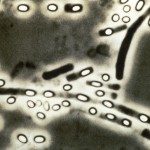Lien vers Pubmed [PMID] – 17635863
Infect. Immun. 2007 Oct;75(10):4754-61
Bacillus anthracis is a spore-forming bacterium that causes anthrax. B. anthracis has three major virulence factors, namely, lethal toxin, edema toxin, and a poly-gamma-D-glutamic acid capsule. The toxins modulate host immune responses, and the capsule inhibits phagocytosis. With the goal of increasing safety, decreasing security concerns, and taking advantage of mammalian genetic tools and reagents, mouse models of B. anthracis infection have been developed using attenuated bacteria that produce toxins but no capsule. While these models have been useful in studying both toxinogenic infections and antitoxin vaccine efficacy, we questioned whether eliminating the capsule changed bacterial growth and dissemination characteristics. Thus, the progression of infection by toxinogenic noncapsulated B. anthracis was analyzed and compared to that by previously reported nontoxinogenic capsulated bacteria, using in vivo bioluminescence imaging. The influence of immunization with the toxin component protective antigen (PA) on the development of infection was also examined. The toxinogenic noncapsulated bacteria were initially confined to the cutaneous site of infection. Bacteria then progressed to the draining lymph nodes and, finally, late in the infection, to the lungs, kidneys, and frequently the gastrointestinal tract. There was minimal colonization of the spleen. PA immunization reduced bacterial growth from the outset and limited infection to the site of inoculation. These in vivo observations show that dissemination by toxinogenic noncapsulated strains differs markedly from that by nontoxinogenic capsulated strains. Additionally, PA immunization counters bacterial growth and dissemination in vivo from the onset of infection.


